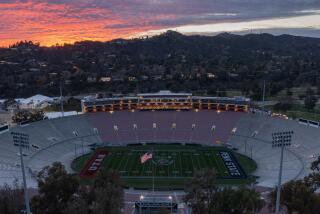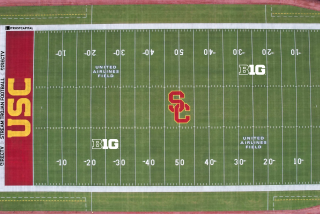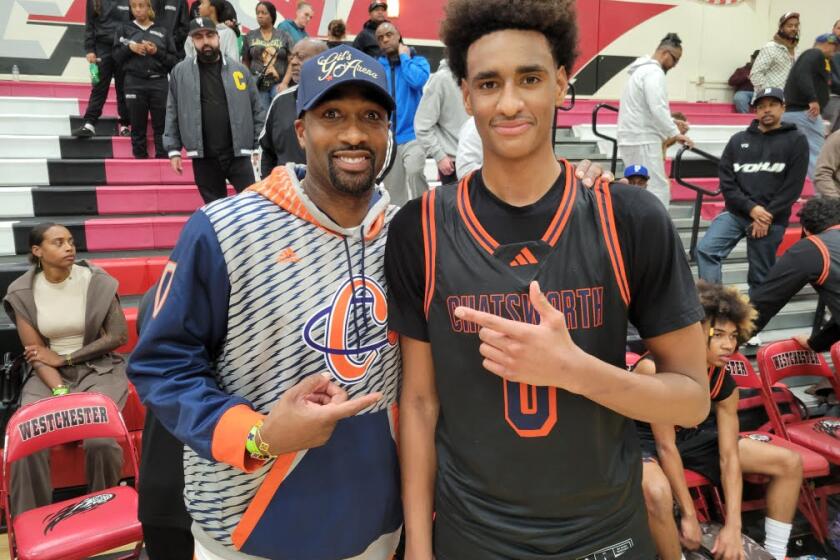ANALYSIS: Coliseum fight puts Rose Bowl ahead as potential fill-in NFL home
Allow me to put the cart before the Trojan horse.
If the NFL returns to Los Angeles â and thatâs still an if â the relocated team is more likely to call the Rose Bowl its temporary home than the Coliseum.
There are a lot of reasons for this, although donât expect backers of either competing stadium plan to make that announcement any time soon. This whole process is about competition â whether itâs the NFL pitting city against city, proposal against proposal, prospective owner against owner â so it makes no sense to publicly eliminate a competitor, even if it is a football stadiumâs answer to a loaner car.
Something to watch: A battle has been brewing for years over control of the Coliseum, and whether the aging venue should be run by a nine-member commission representing the city, county and state, or by USC, which says it wants the stadium to be on par with the standards applied to the campus. That fight was detailed in The Times last Friday.
USC is in a position to send the commission a default letter on Oct. 1 that will state the organization is in violation of the lease because it has not submitted a business plan to show how it intends to pay for roughly $50 million in stadium improvements, less than $10 million of which have been completed.
That business plan was originally due in June 2010 but the commission got a one-year extension. This June, the commission asked for an additional six-month extension but got three months from the school, and was told that was the final extension.
Unless the sides are in discussions for a USC master lease (read: control of the stadium) at that deadline, the default letter is coming.
Under its Coliseum lease, USC can pay for the improvements itself and recover that money by withholding rent to the commission. The commission, in turn, wonât be able to make its rent payments to the state, and that opens the door for the state to step in and cut a deal directly with the university, leaving the commission out of the equation.
Itâs not that the commission is staunchly against the idea of USC taking control of the stadium. While some commissioners have wanted to keep the NFL dream alive, others have shown a willingness to move on and have given serious thought over the years to handing USC the keys.
So what was going to generate all that money for improvements in the first place? The commission thought it could sell naming rights to the stadium and make more than enough money for the upgrades. Four years ago, in fact, USC offered to pay for $100 million in improvements in exchange for a master-lease agreement. The commission rejected that, believing naming rights would save the day.
Turns out there arenât a lot of companies willing to do blockbuster naming-rights deals anymore; that market has become a very difficult one. The Dallas Cowboys donât have a deal yet for their new stadium. Neither do the New York Giants or Jets.
As part of the lease signed in 2008, USC has the right to veto an NFL return to the Coliseum. For years, the school has quietly complained that the commission has put off any improvements to the venue with the thought that the NFL would save the place. Thatâs never happened, and USC is going to push back hard against another suggestion from any commissioners that this time itâs really going to happen.
Simply put, USC is not going to put the improvements on hold yet again because of an NFL promise.
Thereâs another interesting twist to this. Developer Ed Roski, whoâs proposing a stadium in City of Industry, is also chairman of the USC Board of Trustees. If he were to win the stadium derby, would he roll out the Coliseumâs red carpet for the NFL? If AEG were to win, would Roski slap a padlock on the place?
Neither. His right-hand man, John Semcken, said Roski has completely recused himself of any football-related decisions at USC.
David Israel, president of the Coliseum Commission, doesnât think USC will do anything to dissuade the NFL from coming to its home field. He thinks UCLA will make a play for it too, reasoning it could give either school a recruiting advantage, having its home stadium showcased on Saturdays and Sundays.
âIn my opinion, when all is said and done, both schools and the stadium operators would welcome the NFL on a short-term basis,â Israel said. âTherefore, itâs going to fall to the team.â
The Rose Bowl is in the middle of $152 million in renovations, with improvements to tunnels, concessions and restrooms, a new video board, and the creation of 1,160 club seats to go with 54 suites to be ready for the 2013 season. The Coliseum does not have suites or club seats.
The opportunity to sell premium seating â just as he would in the new stadium â would be hugely enticing to the L.A. owner, who will be looking to get the ball rolling on that front for the new stadium.
And donât overlook that the NFL, which probably would have some say, has much better memories of football at the Rose Bowl than at the Coliseum, which was a much different place when the Raiders left after the 1994 season.
UCLA Athletic Director Dan Guerrero, whose school also has the ability to block the NFL from its home field, said the university would not be opposed to sharing the Rose Bowl with a pro team as long as it was a mutually beneficial arrangement.
âSharing the facility with an NFL team would certainly help with the Rose Bowlâs ability to finance the construction,â Guerrero said. âIf it was a win-win situation, then I think weâd be open to it.â
twitter.com/LATimesfarmer
More to Read
Go beyond the scoreboard
Get the latest on L.A.'s teams in the daily Sports Report newsletter.
You may occasionally receive promotional content from the Los Angeles Times.










